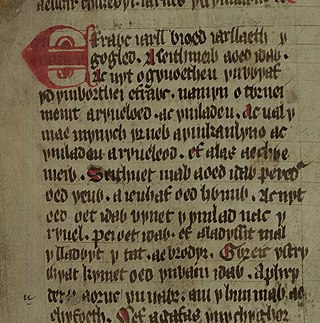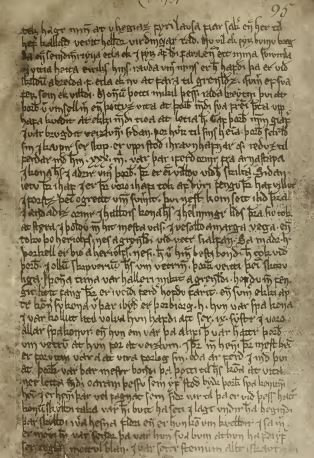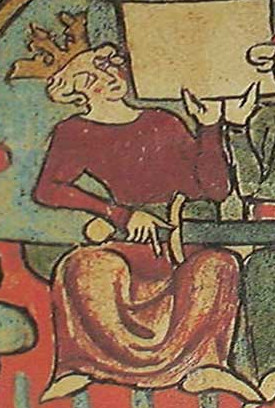Related Research Articles

Völuspá is the best known poem of the Poetic Edda. It dates back to the tenth century and tells the story from Norse Mythology of the creation of the world, its coming end, and its subsequent rebirth that is related to the audience by a völva addressing Odin. Her name is given twice as Heiðr. The poem is one of the most important primary sources for the study of Norse mythology. Parts of the poem appear in the Prose Edda, but the earliest known wholly-preserved version of the poem is in the Codex Regius and Hauksbók manuscripts.

The Poetic Edda is the modern name for an untitled collection of Old Norse anonymous narrative poems in alliterative verse. It is distinct from the closely related Prose Edda, although both works are seminal to the study of Old Norse poetry. Several versions of the Poetic Edda exist: especially notable is the medieval Icelandic manuscript Codex Regius, which contains 31 poems.

Peredur is the name of a number of men from the boundaries of history and legend in sub-Roman Britain. The Peredur who is most familiar to a modern audience is the character who made his entrance as a knight in the Arthurian world of Middle Welsh prose literature.

Hauksbók is a 14th century Icelandic manuscript created by Haukr Erlendsson. Significant portions of it are lost, but it contains the earliest copies of many of the texts it contains, including the Saga of Eric the Red. In most cases, Haukr copied from earlier, now lost manuscripts. Among these are the section on mathematics called Algorismus, the text of Hervarar saga ok Heiðreks. It was originally in one part, but now split in three and held at the Árni Magnússon Institute for Icelandic Studies in Reykjavík, Iceland.
Óláfs saga Tryggvasonar is the name of several kings' sagas on the life of Óláfr Tryggvason, a 10th-century Norwegian king.
Gunnlaugr Leifsson was an Icelandic scholar, author and poet. He was a Benedictine monk at the Þingeyraklaustur monastery in the north of Iceland. Many sources refer to him simply as Gunnlaugr munkr or Gunnlaugr the Monk.

The riddarasögur are Norse prose sagas of the romance genre. Starting in the thirteenth century with Norse translations of French chansons de geste and Latin romances and histories, the genre expanded in Iceland to indigenous creations in a similar style.
Brother Robert was a cleric working in Norway who adapted several French literary works into Old Norse during the reign of King Haakon IV of Norway (1217–1263). The most important of these, Tristrams saga ok Ísöndar, based on Thomas of Britain's Tristan, is notable as the only example of Thomas' "courtly branch" of the Tristan and Iseult legend that has survived in its entirety. It was the earliest Scandinavian version of the story, and is thought to be the first Norwegian adaptation of an Old French work. Its success may have inspired the spate of translations during King Haakon's reign.
Strengleikar is a collection of twenty-one Old Norse prose tales based on the Old French Lais of Marie de France. It is one of the literary works commissioned by King Haakon IV of Norway for the Norwegian court, and is counted among the Old Norse Chivalric sagas. The collection is anonymous. It has been attributed to Brother Robert, a cleric who adapted several French works into Norse under Haakon, the best known of which is Tristrams saga ok Ísöndar, but there is also reason to think that the collection may be a gathering of the work of several different translators. Unlike many medieval translations, the Strengleikar are generally extremely close in sense to the Old French originals; the text which differs most is Milun, which is abridged to half its original length.
Trójumanna saga is a saga in Old Norse which tells the story of the matter of Troy. It is the Old Icelandic translation of the Daretis Phrygii De Excidio Troiae Historia. The saga expands on the basic framework provided by Dares to create a story with many particularly Norse elements and values.

The Prophetiæ Merlini is a Latin work of Geoffrey of Monmouth circulated, perhaps as a libellus or short work, from about 1130, and by 1135. Another name is Libellus Merlini.
Jarlmanns saga ok Hermanns is a medieval Icelandic romance saga. The saga contains the first written evidence for the Icelandic circle dance form known as hringbrot, which is also the first Icelandic attestation of elves dancing.
Breta sögur is an Old Norse-Icelandic rendering of Geoffrey of Monmouth's Historia regum Britanniae with some additional material from other sources. Breta sögur begins with a summary of the story of Aeneas and Turnus, derived from the Aeneid. Along with Rómverja saga, Veraldar saga and Trójumanna saga, it represents the earliest phase of translation of secular works into Old Norse-Icelandic.
Rómverja saga in an Old Norse-Icelandic translation of three Latin historical texts: Sallust's Bellum Jugurthinum and Coniuratio Catilinae and Lucan's Pharsalia. It gives an account of Roman history from the Jugurthine War to the death of Augustus. This combination of sources is unique in medieval literature. Along with Breta sögur, Veraldar saga and Trójumanna saga, it represent the earliest phase of translation of secular works into Old Norse-Icelandic.
Alexanders saga is an Old Norse translation of Alexandreis, an epic Latin poem about the life of Alexander the Great written by Walter of Châtillon, which was itself based on Quintus Curtius Rufus's Historia Alexandri Magni. It is attributed in manuscripts of the saga to Brandr Jónsson, bishop of Skálholt who is also said to have been responsible for authoring Gyðinga saga. Kirsten Wolf has commented on the saga's literary qualities thus: "Alexanders saga [...] has stirred the admiration of scholars and writers for centuries because of its exceptionally imaginative use of the resources of language and its engaging narrative style."
Möttuls saga or Skikkju saga is an Old Norse translation of Le lai du cort mantel, a French fabliau dating to the beginning of the 13th century. The saga tells the story of a chastity-testing cloak brought to the court of King Arthur. It was translated, along with other chivalric sagas, under the patronage of Haakon IV of Norway. Its risqué content suggests that it was translated by clerks rather than in a religious context. Möttuls saga formed the basis for a later set of Icelandic rímur called Skikkjurímur.
Samsons saga fagra is an Old Norse chivalric saga.
Partalopa saga is a medieval Icelandic romance saga deriving from the medieval French Partenopeus de Blois.
Bevers saga or Bevis saga is an Old Norse chivalric saga, translated from a now lost version of the Anglo-Norman poem Boeve de Haumtone. Kalinke summarises the saga as follows:
"The work is a medieval soap opera that commences with the murder of Bevers's father, instigated by Bevers's mother, and carried out by a rival wooer who in turn is killed by Bevers. The ensuing plot includes enslavement, imprisonment, abductions, separations, childbirth, heathen-Christian military and other encounters - Bevers marries a Muslim princess - and mass conversions."
Grega saga is an Old Norse chivalric saga known only from a manuscript that survives as a single leaf: AM 567 XXVI 4to. As it has no known exemplar, it is considered to be an original Old Norse composition. The saga uses motifs found in Ívens saga and Þiðreks saga: a grateful lion becomes Grega's companion and kills three giants. The leaf was written by Magnús Þórhallsson, who worked on Flateyjarbók with Jón Þórðarson.
References
- 1 2 Gropper, Stefanie (2011). "Breta Sögur and Merlínússpá". In Kalinke, Marianne E. (ed.). The Arthur of the North: The Arthurian Legend in the Norse and Rus' Realms . Cardiff: University of Wales Press. pp. 48–60. ISBN 9781783167876.
- 1 2 Kalinke, Marianne E. (2011). "The Introduction of the Arthurian Legend in Scandinavia". In Kalinke, Marianne E. (ed.). The Arthur of the North: The Arthurian Legend in the Norse and Rus' Realms. Cardiff: University of Wales Press. ISBN 9781783167876.
- 1 2 Marold, Edith (1993). "Merlínusspá". In Pulsiano, Phillip; Wolf, Kirsten (eds.). Medieval Scandinavia: An encyclopedia. New York: Garland. pp. 412–413. ISBN 0824047877.
- ↑ Kalinke, Marianne (2015). "Arthur, King of Iceland". Scandinavian Studies. 87 (1): 10. doi:10.5406/scanstud.87.1.0008. ISSN 0036-5637. JSTOR 10.5406/scanstud.87.1.0008.
- ↑ Kalinke, Marianne (2015). "Arthur, King of Iceland". Scandinavian Studies. 87 (1): 9. doi:10.5406/scanstud.87.1.0008. ISSN 0036-5637. JSTOR 10.5406/scanstud.87.1.0008.
- ↑ Poole, Russel (2005). "Metre and Metrics". In McTurk, Rory (ed.). A Companion to Old Norse-Icelandic Literature and Culture . Malden, Oxford, Victoria: Blackwell Publishing. pp. 265.
- ↑ Clunies Ross, Margaret (2005). A History of Old Norse Poetry and Poetics . Cambridge: D. S. Brewer. pp. 12. ISBN 9781843842798.